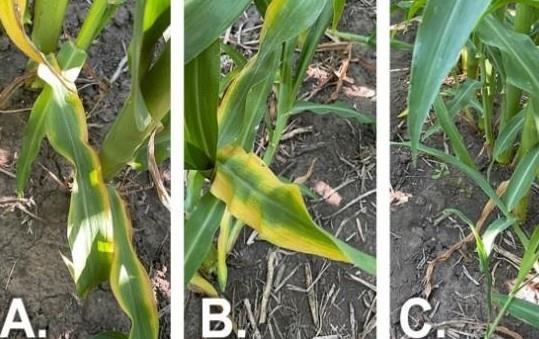By Jason Clark
Potassium (K) is an essential plant nutrient, and corn will take up approximately 85 pounds (lbs.) of K per acre (ac) each year. For many crop producers, potassium deficiency has become an increased concern, and this year’s drought conditions have resulted in potassium deficiency symptoms showing up in fields where it would normally not occur. Potassium can easily be moved within the plant from older to younger leaves. Therefore, potassium deficiency symptoms first appear on older leaves. The visual symptoms normally include a yellowing to brown leaf tissue starting at the tip of the leaf and expanding down the margin (outer edge of leaf). These symptoms usually occur around four to six weeks after corn planting (V6 growth stage) when plants start growing rapidly and demand a large amount of potassium.

Figure 1. Potassium (K) deficiency symptoms where leaf yellowing started at the tip of older leaves and moved down the leaf margins where (A) 0 lbs. and (B) 90 lbs./ac. were applied at planting; a healthy plant where (C) 150 lbs./ac. was applied.
Potassium deficiency symptoms can occur even though soil potassium levels are sufficient to optimize corn production (>160 parts per million - ppm). This deficiency occurs because corn plants need an actively growing root system and water in the soil to aid in the slow movement of potassium to roots. When soil conditions are dry, root growth slows and the speed that potassium in the soil can reach the plant root and be taken up slows down, potentially resulting in potassium deficiency symptoms. Potassium uptake can also be limited in tilled soils where soils have not settled sufficiently since tillage. The lack of settling results in poor contact between soil particles, slowing down the movement of potassium through soil water to plant roots. Therefore, potassium deficiency is sometimes not seen in the wheel-track areas, where soil is settled and well firmed, but it is seen between wheel-track areas. Further, soils with high amounts of smectite clays collapse in dry conditions, resulting in temporarily making the potassium held by these clays unavailable to plants. Recent research shows that these smectite clays are more common in the eastern part of South Dakota and less common in central and western South Dakota. Other soil factors that limit root growth or water uptake including compacted soil, root pruning by insects, diseases and sidewall compaction of the seed furrow, which can also limit potassium uptake and result in potassium deficiency symptoms even when soil potassium levels are sufficient.
Correcting Potassium Deficiency
In a drought year potassium deficiency is most often caused by the unavailability of potassium for plants to take up and not the lack of potassium in the soil. Therefore, if soil test potassium levels are adequate, or sufficient fertilizer was applied prior to planting, it is best to wait for precipitation to occur that will increase the availability of potassium already in the soil for uptake by plants. Once adequate precipitation is received, potassium deficiency symptoms often decrease or disappear. Insufficient data is available in South Dakota looking at the effectiveness of rescue treatments where fluid or dry potassium fertilizers are applied in-season to corn. Some studies in other states do show that a positive response to in-season potassium is possible. However, additional potassium applications will still not be sufficient if drought conditions continue. Therefore, the economic effectiveness of these rescue treatments is unknown.
Preventing Future Potassium Deficiency
The best way to prevent future potassium deficiency in crops is to apply enough fertilizer before planting based on soil test potassium levels. This year’s potassium deficient areas can be marked with GPS units and soil sampled after harvest. These soil samples can then be tested for plant-available potassium. This information can then be used to appropriately apply potassium fertilizer to these areas for the next crop.
Source : sdstate.edu